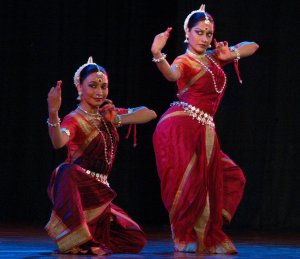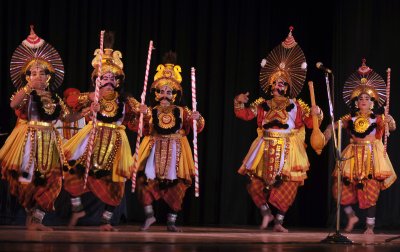
|   |

|   |
The Music Academy Dance Fest: Day 7 - Veejay Sai e-mail: vs.veejaysai@gmail.com Photos: Thanthoni February 2, 2012 The Power Puff girl The last day of the Academy’s festival opened its morning session with a solo Odissi dance performance by Arushi Mudgal. May be it was the scheduling of the Academy to have less Bharatanatyam on the last day, that the hall didn’t look as full as it would have on other days. But watching Arushi’s performance one could clearly say what dance lovers who didn’t turn up, missed.  Arushi started with a Ganesha Mangalacharan composed by Pandit Vinay Chandra Maudgalya and choreographed by Late Guru Kelucharan Mohapatra. From the very beginning, Arushi exhibited her penchant for the dance form with her superb stage presence. Emerging from the signature tribhangi and getting back to it via her nritta and abhinaya, Arushi was all set to take the audiences for a wonderful ride into the ancient temple art of Orissa. In the next pure dance piece she performed, Arushi exhibited her own choreographic skills. Dancing to music set by her father Madhup Mudgal, Arushi’s nritta was matchless. Of what value would any Odissi performance be without a signature Ashtapadi or two? Arushi performed ‘Yaami hey’ choreographed by her eminent aunt Madhavi Mudgal. The piece de résistance for Arushi’s performance was ‘Kede chhanda janalo sahi, nanda rajara tiki pilati’ composed by the great Oriya poet Banamali which was also one of late Kelubabu’s evergreen numbers. Even as the music began, there were several veteran dance connoisseurs in the audience who began humming the tune and whispering amongst themselves with a familiar smile on their face. Arushi recreated the magic all over again with her graceful gaiety. Set to Misra Kaafi raag and tuned by Pandit Bhuvaneshwar Mishra, those of us who have seen Kelubabu perform this know what a delightful piece of choreography it is. Arushi’s abhinaya as she narrated the episodes of Krishna’s leelas of ‘Bakasura,’ slaying of Kalia and showing the entire cosmos to his mother as he opens his mouth, were worth watching over and over again. Many dancers have performed this item since Kelubabu choreographed it and made it famous, but no one does justice to it like Arushi does. Pickled in her art form, Arushi certainly leads the young brigade of Odissi dancers into the next generation more than anyone else. Supported by her sister Sushri Sawani Mudgal on the vocals and Srinibas Satpathy’s melodious flute, the first performance of the day started on a very promising note. Kunti still haunts ‘Yet another mono-act on Kunti?!’ exclaimed a rasika as the curtains opened to the second performance for the morning. Soon perceptions changed in the time that followed, that it was not ‘yet another kunti’ but a completely transformed and more enjoyable solo performance by Chitra Chandrasekhar Dasarathy. The daughter and disciple of the dancer-couple gurus Jaya and CV Chandrasekhar, Chitra presented a poignant Kunti with a twist in the narrative.  Everyone who is familiar with the Mahabharata is aware of the story of Kunti. As a protagonist, she has also been represented, rewritten and replayed endless by feminists, activists, playwrights and the like. What doesn’t change about Kunti, however which way she is represented is the angst of a mother who lost her children. Using textual references like the Mahabharata, Srimadbhagavatam and ‘Rasmirathi,’ a Hindi poem by the legendary Ramdhari Singh ‘Dinaker,’ Chitra’s dance stuck close to the characterization. In one of the most touching scenes from the Karna-Kunti samvaadam when Kunti meets her son Karna who introduces himself as ‘Radheyoham’ (the son of Radha), Kunti cries her heart out asking him to say ‘Kaunteyastvam’ (son of Kunti), one could feel the tension in the character that Chitra brought about and the agony in her vaachika abhinayam. The sight of guilty pangs of a mother who feels she did injustice to her son were heart wrenching. Using a minimalistic visual narrative and adding just the right kind of props to suit the various roles of the characters, Chitra’s portrayal was a spectator’s delight. One wondered why the singer Manasi Prasad started off on a high note and tried to go higher as her vocal chords gave in. Mono-acts on mythological characters can be tediously boring after a while but Chitra managed to pull off a good show. Poetic gestures In spite of the fact that several prominent practitioners of Odissi in Orissa do not accept what the Nrityagram girls do, when Bijayini Satpathy enters the stage for a performance, she takes the audiences by storm. She doesn’t dance. She glides two inches over the floor and takes you with her in an easy sweep of each and every graceful gesture she portrays. And that is exactly what she did as she opened the first show for the last evening of the festival. As she floated her way down to the lines ‘murahara naghadhara mukunda madhava, garuda gamana pankaja nabha,’ one could see the smile on the statue of Lord Jagannatha placed in the corner of the stage, widen with joy. You could close your eyes for a second and visualize a graceful garuda flap its magnanimous wings with elegance. Bijayini’s each and every movement arose from deep within the heart of a genuine artiste oozing refinement and confidence.  In the next item, a popular ashtapadi ‘Dheera sameere Yamuna there,’ both Bijayini and Surupa Sen exhibited what it is to choreograph their each and every movement to bring about a lyrical synergy. What to look at as a rasika? Radha’s jealousy being subtly portrayed as Krishna romances another nayika? The wonderful music composed by the legendary Raghunath Panigrahi? The soulful flute played by Srinibas Satpathy? Or just the visual treat both these dancers were presenting on stage? In days when there are so many dancer-couples doing all sorts of things in the name of choreography, one could surely take a lesson or two in how not to be repetitive and how to exhibit fluidity and synchronization from these Nrityagram girls. They certainly rank as one of the finest dancers of Odissi in our country today. Watching them perform was looking at sheer undiluted poetry, come alive on stage. Grand finale from the epics For such a big festival of dance, the Academy lined up a finale that was equally befitting and grand. For those who missed it, they certainly missed one of the finest visual treats they could have ever gotten to see in a Chennai Margazhi. The country’s best Yakshagana troupe, the Idagunji Mahaganapati Yakshagana Mandali from Keremane, headed by the able Keremane Shivananda Hegde performed a fabulous show of ‘Dhuryodhana Vadha,’, a Yakshagana classic for Chennai’s dance lovers.  The play begins on the eighteenth day of the Kurukshetra war when Dhuryodhana loses all his kith and kin in the war and the Pandavas are looking for him. The play starts with a colorful traditional Poorvaranga and an invocation to Lord Ganesha. Set into eight scenes, right on from the entry of the Pandavas, through the dialogue with Krishna, the war between Bhima and Dhuryodhana, till the fall of Dhuryodhana when he is hit on his thigh by Bheema’s mace, the colorful costumes and the superb dialogues were worth listening to a hundred times. Everyone who has watched earlier performances of this troupe knows how the poignant role of Dhuryodhana was portrayed by the late legendary Keremane Shambhu Hegde. Seeing his able son Shivananda Hegde portraying the same role sent rasikas on a nostalgic trip down memory lane. Due to time constraint they had to wind up the show earlier and in a hurry. Wish the Music Academy had given them a full evening, if not for anything else, just for rasikas to sit back and enjoy an ancient dying art form being performed by such committed and passionate artistes. There is always a next time. With this, the week-long dance festival organized by the prestigious Madras Music Academy concluded with a promise to return in a bigger and better shape next year. Wishing the Academy, its committee members and the wonderful rasikas, who thronged in large numbers, yet another promising season ahead. Veejay Sai is a writer, editor and a culture critic. |